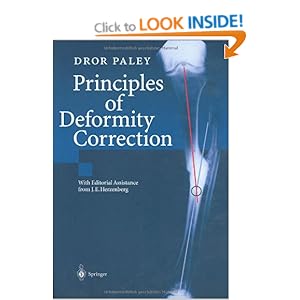Paley Principles Of Deformity Correction Pdf Download Free Apps
• 1.7k Downloads • Abstract Fibular hemimelia presents with foot deformity and leg length discrepancy. Previous classifications have focused on the degree of fibular deficiency rather than the type of foot deformity. Published methods of surgical reconstruction have often failed due to residual or recurrent foot deformity. The purpose of this report is to introduce new classification and reconstruction methods. Avast internet security final licence avastlic 2038 problem.
The Paley SHORDT procedure is used to stabilize the ankle when there is a hypoplastic distal fibula with a dynamic valgus deformity. It involves shortening and realignment of the distal tibia relative to the fibula. In contrast, the Paley SUPERankle procedure is used when there is a fixed equinovalgus foot deformity. The SUPERankle uses a supramalleolar shortening-realignment osteotomy and/or subtalar osteotomies with anlage resection. Due to the bony instead of soft tissue correction of deformity, residual or recurrent deformity is prevented. Weakening of gastro-soleus and peroneal muscles is avoided by shortening of the tibia instead of tendon lengthening. The limitation of ankle motion is related to ankle dysplasia rather than surgery or lengthening.
Jan 15, 2018 - Other Results for Paley Principles Of Deformity Correction Pdf: • Ilizarov principles of deformity correction Ilizarov frames provide a versatile.
 A plantigrade-stable foot and ankle leads to an excellent functional result comparable or better than a Syme’s amputation with prosthetic fitting. Serial lengthening procedures combined with the SHORDT or SUPERankle reconstruction lead to limb length equalization with a plantigrade, painless, functional foot.
A plantigrade-stable foot and ankle leads to an excellent functional result comparable or better than a Syme’s amputation with prosthetic fitting. Serial lengthening procedures combined with the SHORDT or SUPERankle reconstruction lead to limb length equalization with a plantigrade, painless, functional foot.
Fibular hemimelia (FH) is a congenital deficiency where part or all of the fibular bone is hypoplastic, dysplastic or aplastic associated with hypoplasia and dysplasia of the tibia and hypoplasia, dysplasia and aplasia of parts of the foot. The phenotype has a wide spectrum of pathology, ranging from mild to severe limb length discrepancy, ankle/foot deformities with or without subtalar coalition, midfoot coalitions and absent rays.
Knee ligament deficiencies and knee valgus deformity as well as associated femoral hypoplasia, dysplasia and partial aplasia are common. It is therefore part of the same spectrum of deficiency as congenital femoral deficiency. These are commonly referred to as postaxial deficiencies and are distinct in their pattern from preaxial deficiencies such as tibial hemimelia. FH occurs in between 1:135,000 and 1:50,000 births [,, ]. Bilateral FH (fibular hemimelia affecting both legs) occurs much less commonly. The etiology of FH remains unknown, and in most cases it is usually not an inheritable condition, with the vast majority of children born with this condition having no family history of other birth defects. The exception to this is when FH is associated with deficiency in more than one limb; for example, bilateral FH is often an autosomal dominant condition.
When multiple limbs are affected by a limb deficiency, one can often assume that this was either an autosomal-dominant gene disorder (inherited or new mutation) or related to a teratologic agent (drug, radiation, virus, etc.). FH has been reproduced in a mouse model [ ], suggesting that in most cases it may be a somatic gene mutation, although this theory has not been confirmed. Limb length discrepancy Unilateral FH leads to a limb length discrepancy due to inhibition of growth of the tibia and foot. In addition, many children with FH have some femoral growth inhibition (congenital femoral deficiency). The foot grows shorter in height, contributing to limb length discrepancy, but it is also shorter in length. This limb length discrepancy follows a Shapiro 1a curve, meaning its growth inhibition remains constant [ ]. This characteristic makes the leg length discrepancy of FH predictable using the Anderson and Green [ ], Moseley straight line graph [ ], Amstutz method [ ] or Paley Multiplier method [ ].

The limb length discrepancy with FH ranges from very mild to very severe inhibition, ranging at maturity of the patient from 2 to 25 cm in the absence of femoral deficiency discrepancy. With combined inhibition of the femur and tibia the magnitude of leg length discrepancy at maturity can be >30 cm. Foot and ankle deformities Foot and ankle deformities have been the most challenging and disabling problems with FH.
